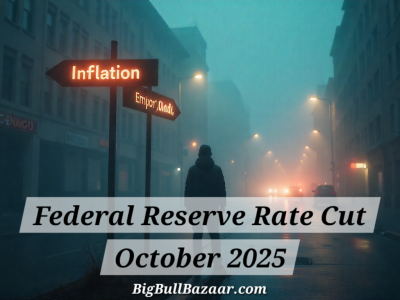Fed Rate Cut: 3 Key Takeaways for Every Retail Investor
If you’ve been watching the financial news, you know the Federal Reserve just made a big decision. The headlines can be confusing, filled with terms like "basis points" and "quantitative tightening." But what does it all mean for you, the individual investor?
Let's cut through the jargon and break down the Fed's October 2025 meeting into three simple takeaways for your wallet and your portfolio.
1. The "Why": The Fed is Worried About the Job Market (And That's a Big Deal)
What Happened: The Fed cut its key interest rate by 0.25%. This is the second cut this year.
What It Means for You:
This move tells us the Fed’s top concern is shifting. For the past few years, it's been all about fighting inflation. Now, the official statement notes "downside risks to employment." In plain English? They’re worried the job market is cooling off and want to give the economy a boost to prevent a sharper slowdown.
· For Your Loans: This is potentially good news if you have debt. A Fed rate cut often leads to lower rates on credit cards, home equity lines of credit (HELOCs), and new auto loans. If you've been considering a major purchase financed by debt, locking in a rate now might be wise.
· For Your Savings: The downside is that the interest rates on your high-yield savings accounts and Certificates of Deposit (CDs) will likely start to creep down. The era of 4%+ risk-free returns is likely coming to an end. If you have cash sitting on the sidelines, consider locking in a longer-term CD soon if the rates are still attractive.
2. The "What Next": Powell Just Put a "Pause" on the Table
What Happened: Fed Chair Jerome Powell was surprisingly cautious. He said there are "strongly differing views" on what to do next and that a December rate cut is not guaranteed.
What It Means for You:
Don't expect automatic rate cuts every few months. The market got a little too excited, and Powell pumped the brakes. The Fed is in "wait-and-see" mode because a government shutdown has left them without key data on jobs and inflation. He said they're "driving in the fog."
· For Your Stock Portfolio: This uncertainty is why the stock market reacted with volatility. Markets love predictability, and Powell just introduced doubt.
· Be Prepared for Choppiness. We might see more ups and downs in the coming weeks as investors react to every piece of news.
· Stick to Your Strategy. This is not the time for drastic moves. If you're a long-term investor, stay the course with your diversified portfolio. Market timing based on Fed predictions is a risky game.
· Focus on Quality. Companies with strong balance sheets and stable earnings tend to weather economic uncertainty better than highly indebted, speculative ones.
3. The "Stealth Ease": A Win for the Housing Market and Stocks
What Happened: In a major but under-reported move, the Fed announced it will stop shrinking its massive bond holdings in December. This is a big deal.
What It Means for You:
Think of this as a "stealth" form of economic stimulus. By stopping this process (called Quantitative Tightening), the Fed is taking its foot off the brake in another way. This helps keep long-term interest rates lower.
· For Your Mortgage: This is excellent news for the housing market. Lower long-term rates mean more affordable 30-year fixed-rate mortgages. If you've been waiting for a better moment to buy or refinance, this could be your signal to start paying closer attention.
· For Your Investments: This action generally provides a supportive backdrop for the stock market and bond market. It means the Fed is committed to not tightening financial conditions too much, which can help company valuations and make borrowing easier for businesses.

Your Action Plan
1. Review Your Debt: Look at your variable-rate debts (like credit cards). If rates start to fall, make a plan to pay them down more aggressively.
2. Lock in Savings Rates: If you rely on interest from savings, scout the best CD or high-yield savings account rates now before they potentially decline further.
3. Stay Calm and Invest On: Ignore the day-to-day noise. Powell’s message is one of caution, not alarm. The Fed is trying to engineer a "soft landing," and for long-term investors, staying invested through cycles has historically been the winning strategy.
4. Consult a Pro: If you're feeling uncertain, it's always a good time to talk to a qualified financial advisor who can help you adjust your plan based on your personal goals and risk tolerance.
Disclaimer: This article is for informational purposes only and does not constitute financial advice. Please consult with a qualified financial professional before making any investment decisions.




Leave a Reply